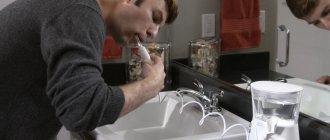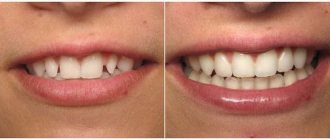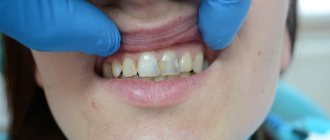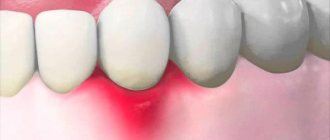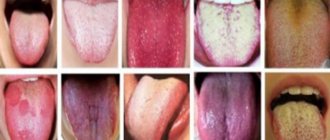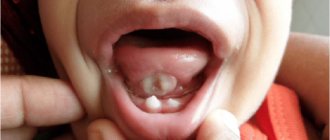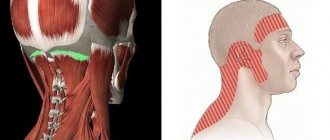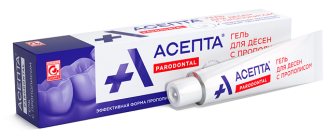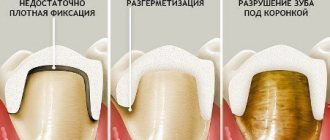05.10.2021 317
Patients often turn to dentists because they are faced with the problem of black plaque on their teeth. This greatly spoils the aesthetics of a smile, brings inconvenience, and stimulates the appearance of complexes and barriers to communication.
You also need to understand that black plaque on a tooth indicates serious problems in the body that need to be eliminated as soon as possible. Sometimes it can be accompanied by pain and bad breath.
In this material we will talk about what leads to the appearance of dark plaque and what methods dentists use to deal with it.
Why plaque and stone are dangerous
The plaque that settles on the teeth is soft. It can be easily removed with any hygiene products. Within 6-12 hours it reacts with the components of saliva, becomes saturated with calcium salts and hardens. The only way to prevent this is to use mouthwash throughout the day. Once the plaque has hardened, it can no longer be removed.
Tartar gradually forms. It continues to grow as new layers of plaque easily “stick” to the rough surface. After about 6 months it becomes visually noticeable, but this is not its main danger.
The stone grows in the cervical part of the crown, gradually penetrating into the subgingival area. This leads to mechanical damage to the gums and loosening of the teeth. Microorganisms cause gum inflammation and provoke more severe oral diseases. Patients complain of bleeding and sensitivity of the gums, and bad breath. With further growth of the stone deeper into the gums, there is a risk of developing cysts on the root of the tooth.
Consequences of regularly getting food stuck between teeth
Some people don’t even think about how to get stuck food out of their teeth. They are guided by the principle, it doesn’t hurt and it’s okay, making a big mistake. Meanwhile, such neglect can lead to dire consequences. For example:
- Gum diseases - food debris is an irritant that damages the mucous membranes, which provokes the development of dental diseases: gingivitis, periodontitis, etc.;
- Unpleasant odor - the food remaining between the teeth begins to decompose, which, in addition to the amber, creates a favorable environment for the life of pathogenic bacteria;
- Root injury – irritation of the gums can cause exposure of the neck of the tooth, which increases sensitivity and causes pain;
- Caries - stuck pieces of food is one of the main causes of carious lesions of the enamel; this disease can only be eliminated through dental intervention;
- Tissue destruction – if you do not clean the interdental space, the teeth begin to gradually deteriorate, which can lead to complete loss.
Causes of congestion
- Insufficient oral hygiene, incorrectly selected hygiene products.
- Eating a lot of sweets, sticky foods, rich in light carbohydrates, and at the same time a small amount of solid foods, such as vegetables, in the diet.
- Abuse of products that have a coloring effect. Tea, coffee, cola, carbonated drinks - all this leads to the fact that the plaque turns brownish and, after hardening, spoils the smile.
- Diseases of internal organs. Patients with diseases of the gastrointestinal tract and endocrine system are prone to the formation of plaque on their teeth.
- Partial edentia, malocclusion, severe crowding of teeth.
Patients with bridge prostheses are at risk. The bridge is fixed on the supporting tooth. Food particles get trapped under the crown. In this case, cleaning plaque on teeth with conventional means is impossible. As a result, it grows, microorganisms attack the gums and supporting teeth, and it becomes mobile. If you have dentures, you should definitely visit your dentist for professional cleaning.
The main reasons for the appearance of black plaque
- Constant drinking of coffee and smoking.
This is the most important factor in the appearance of plaque. Cigarettes and coffee contain toxic substances that have coloring properties. They quickly penetrate the plaque and paint it black. After which it is securely attached to the enamel, forming tartar.
- Consequence of illness or use of medications.
If you take antibiotics for a long period, plaque will definitely appear. This is especially true for people who have liver problems.
- Professional activity.
Black teeth may appear in those who work in chemical industrial plants. This is most often encountered by workers at metallurgical plants. Condensation with elements of heavy metals settles not only on internal organs, but also on teeth.
- Dysbacteriosis.
Young children are especially susceptible to this. This can happen because the intestinal microflora is not yet formed. And under no circumstances should you rush to clean plaque from your baby’s teeth. This problem will disappear on its own over time.
- Drug use.
Drug addiction causes complete destruction of the body. Teeth are also susceptible to the harmful effects of drugs.
Important! Manufacturers often treat apples with formaldehyde to help them last longer. And in the winter and spring seasons, when it’s not the season, we buy processed apples. And harmful substances enter the body and provoke black plaque.
Types of plaque
- Soft. Formed on teeth during human life. It is not noticeable on the surface of the enamel and is easily removed from it using hygiene products.
- Solid. Once hardened, it is almost impossible to remove plaque from teeth at home.
- Supragingival stone. Formed from hard plaque. Outwardly it looks like a small dark-colored rim in the cervical area.
- Subgingival stone. It is formed under the gum, so it is not visually noticeable. It can only be detected using a special dental probe or an x-ray. If subgingival stone is not removed in time, gum resection may occur.
Getting rid of plaque at home
Bleaching yourself is extremely dangerous. But folk craftsmen came up with such ways to combat black plaque.
- Mix peroxide and soda (1 tsp each). The mixture should be applied to cotton wool and gently rubbed onto the black tooth. After finishing the procedure, rinse your mouth with water at room temperature. Such polishing cannot often be carried out. Otherwise, the enamel may be damaged.
- Pour boiling water over a small amount of chopped bean skin and burdock root. You need to insist for a couple of hours. You should rinse your teeth with the resulting drink until the plaque disappears. It is recommended to warm the infusion a little before rinsing.
- Prepare your own personal dental powder. To do this, take foil and place a few tablespoons of dry sage leaves with sea salt on it. Then the foil is placed in the oven, which has been preheated prematurely, for half an hour. After this, remove the mixture from the oven and leave it to cool. Then the mixture is crushed. This is how teeth powder is prepared. They use it seven times a day.
Home Remedies
Home remedies for plaque removal are rather preventative. In order to maintain dental health, it is necessary to follow the rules of hygiene:
- Brush your teeth twice a day with a toothbrush and suitable toothpaste.
- Use toothpicks and dental floss after meals, as the brush cannot reach hard-to-reach places.
- Use mouthwash regularly.
Small plaque can be removed using pastes containing abrasives or tooth powder. When using them you need to be careful, as you can damage not only the enamel, but also the mucous membrane of the gums. You need to be even more careful if you decide to remove plaque from your teeth with whitening agents - soda, hydrogen peroxide. Their uncontrolled use can cause problems with dental health.
How to remove food if it's stuck between teeth
If food gets stuck between your teeth and your breath smells, you need to use hygiene products to care for your teeth.
The most common cleaning methods:
- The toothpick should be positioned at an angle of 30-40 degrees relative to the gum, pressed against the gingival papilla and the plane of the tooth. Remains of food are removed by moving the toothpick upward.
- Dental floss. The floss is pinched with your fingers and inserted into the interdental space. Cleaning with dental floss is carried out in a reciprocating motion.
It is important to understand here that both of these methods are quite traumatic, and any careless movement can damage the gums. Then how to remove food stuck between teeth? To do this, you can use an irrigator.
Irrigators are absolutely safe to use: pieces of stuck food are removed with a stream of water. This allows you to efficiently clean even hard-to-reach places without damaging the gums and interdental spaces. In addition, irrigators are ideal for the care of denture structures.
Possible complications
Of course, with brown layers there is no need to talk about aesthetics. This is an important aspect, but not the main one. Deposits must be removed before they cause serious oral ailments. When the enamel turns black, an irreversible problem develops, such as gingival bleeding caused by plaque around the gums, or tartar, periodontitis or gingivitis, complete destruction of the enamel and increased sensitivity of the units. When the first signs of darkening appear, you should immediately consult a doctor. Do not ignore the disease, as it may indicate diseases of the internal organs.
In such a situation, the patient is referred for consultation to a gastroenterologist, endocrinologist or infectious disease specialist. After receiving information from specialists, the dentist develops a program to restore the color of the affected units and remove plaque between the teeth. If tuberculosis or diabetes mellitus, allergies or parasite infection, gallbladder dyskinesia or other serious ailments are diagnosed, the dentist begins work after treating them.
Blackening of the wisdom tooth
It is not uncommon for patients to come to the clinic with a similar complaint. As a rule, “eights” erupt with problems and with severe pain, and besides, they appear already spoiled. Often, such teeth are simply removed, since they do not bear any load when chewing, and also do not affect aesthetics.
Treatment, of course, can be carried out, but it will be labor-intensive and in most cases useless. It will still need to be removed. We advise you to think carefully before starting treatment.
Irrigator device
The main device of the device is the same for different types and models and consists of:
- Water reservoir. Some irrigators have their own reservoir, but there are also models that can be directly connected to tap water;
- Reinforcing part. As a rule, to impart pressure to the supplied jet, a built-in electric pump or a mechanical pump button is used;
- The nozzle is a divider. As a rule, this is a removable and replaceable element necessary for supplying a jet and performing certain tasks. Nozzles come in different types and are selected depending on the needs.
There are 6 types of attachments: standard, orthodontic, periodontal, implantation, tongue cleaner and nasal
Prevention measures
To prevent problems of this nature from arising, you should quit smoking. It is necessary to limit the introduction of drinks with a coloring effect into the diet, especially coffee. The menu should actively include solid foods that are rich in fiber. In this way, natural cleaning is carried out. Take care of your oral cavity daily, including not only cleaning your incisors and molars, but also your tongue. Use special threads, as well as medicated rinses. If you still need medical help, contact a clinic that provides dental treatment in St. Petersburg. Regular visits to the dentist will allow you to correctly determine the condition of the oral cavity and correctly prescribe therapy.
Diagnosis of Priestley plaque on teeth
If darkening is detected on the enamel of a child’s teeth, you must contact a dental clinic.
The specialist will:
✔
inspection;
✔
laser diagnostics to determine the depth and size of the lesion;
✔
anamnesis collection.
After a conversation with the parent and child and collecting an anamnesis, the pediatric dentist will immediately prescribe treatment or conduct an additional examination. You should not neglect it - it is important for a specialist to find out why the child has black plaque on his teeth. Only after this will he be able to provide quality treatment.
Laser
Removal using laser. This method is gentle and allows you to preserve the enamel. The procedure is painless and does not harm the enamel. For example, when sandblasting your teeth, your gums may begin to bleed, but a laser will save you from this unpleasant moment.
NOTE: not every clinic provides such a service, and its cost cannot be called low. The price for laser therapy starts from 3 thousand rubles. in one session.
The photo shows laser deep cleaning of stones and plaque
How does a dentist remove plaque?
Modern dentistry knows many methods to improve your smile. This is why most people turn to professionals for help. There are two most popular ways to get rid of black plaque in children and adults.
Jet method
This method involves the release of sodium bicarbonate under high pressure from the tip onto the tooth enamel. Under pressure, it quickly removes age spots and plaque.
Using Ultrasound
Recently, it has become popular to use ultrasound. This method is much stronger than the inkjet method. It is even capable of removing tartar. For this purpose, a special nozzle is used under the influence of vibrations of a high-frequency generator. At this time, plaque is destroyed by vibration waves. After completing the procedure, you need to remove any remaining deposits with water.
The ultrasound procedure is quite expensive, so not everyone can afford it.
